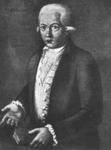Joseph-Hector Fiocco
Joseph-Hector Fiocco | |
|---|---|
 | |
| Born | 20 January 1703 Brussels |
| Died | 21 June 1741 (aged 38) Brussels |
| Occupations |
|
| Organizations |
|
Joseph-Hector Fiocco (20 January 1703 – 21 June 1741), born in Brussels, was a composer and harpsichordist of the late Baroque period.
His father, the Italian composer Pietro Antonio Fiocco, and one of his older step-brothers Jean-Joseph Fiocco gave him much of his musical education.
He also learned Greek and Latin well enough to be able to become a school teacher in both those subjects.
Joseph Hector Fiocco worked under his stepbrother's direction at the Ducal Chapel of the Notre-Dame du Sablon most sources cite some time before 1730. In 1730, Joseph Hector became sous-maitre (submaster) of the Notre-Dame du Sablon; he did not keep this position for long, because he resigned in 1731 to become sangmeester (choirmaster) at Antwerp Cathedral.
At Antwerp (1731–37) he was in charge of the music. In 1737 he returned to his birthplace and worked in the collegiate church of St. Michael and St. Gudula. He died in Brussels at the age of 38.[1]
In connection with his cathedral employment, Fiocco wrote many choral works, including
Sources
- Satz, Don. "Review". Retrieved 2006-10-17.
- Stellfeld, Christiane. Les Fiocco, une famille de musiciens belges aux XVIIe et XVIIIe siècles. Imprint [Brussels, Palace of Academies, 1941] 172 pages, 3 leaves, illustrations (including ports., facsimiles, music) 29 cm [1]
- ISBN 978-1-56159-263-0– via Oxford Music Online.
External links
